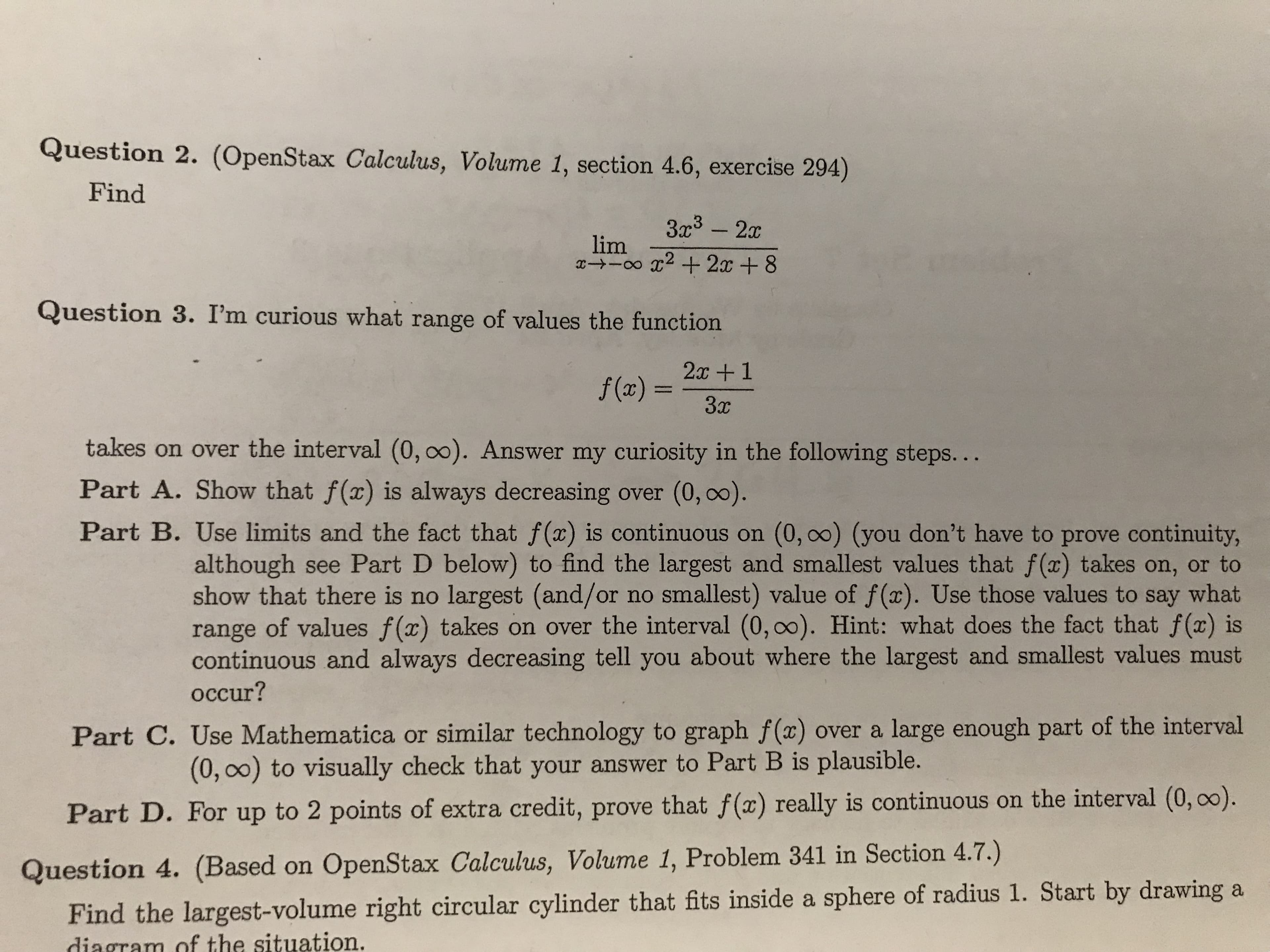Question 2. (OpenStax Calculus, Volume 1, section 4.6, exercise 294) Find 3a3 -2 lim Question 3. I'm curious what range of values the function 2c+1 takes on over the interval (0, 00). Answer my curiosity in the following steps... Part A. Show that f (x) is always decreasing over (0, oo). Part B. Use limits and the fact that f(x) is continuous on (0, 00) (you don't have to prove continuity, although see Part D below) to find the largest and smallest values that f (x) takes on, or to show that there is no largest (and/or no smallest) value of f(x). Use those values to say what range of values f(x) takes on over the interval (0,00). Hint: what does the fact that f(x) is continuous and always decreasing tell you about where the largest and smallest values must occur? Part C. Use Mathematica or similar technology to graph f(x) over a large enough part of the interval (0, 0o) to visually check that your answer to Part B is plausible. Par t D. For up to 2 points of extra credit, prove that f(a) really is continuous on the interval (0, 00). Question 4. (Based on OpenStax Calculus, Volume 1, Problem 341 in Section 4.7.) Find the largest-volume right circular cylinder that fits inside a sphere of radius 1. Start by drawing a diagram of the situation
Question 2. (OpenStax Calculus, Volume 1, section 4.6, exercise 294) Find 3a3 -2 lim Question 3. I'm curious what range of values the function 2c+1 takes on over the interval (0, 00). Answer my curiosity in the following steps... Part A. Show that f (x) is always decreasing over (0, oo). Part B. Use limits and the fact that f(x) is continuous on (0, 00) (you don't have to prove continuity, although see Part D below) to find the largest and smallest values that f (x) takes on, or to show that there is no largest (and/or no smallest) value of f(x). Use those values to say what range of values f(x) takes on over the interval (0,00). Hint: what does the fact that f(x) is continuous and always decreasing tell you about where the largest and smallest values must occur? Part C. Use Mathematica or similar technology to graph f(x) over a large enough part of the interval (0, 0o) to visually check that your answer to Part B is plausible. Par t D. For up to 2 points of extra credit, prove that f(a) really is continuous on the interval (0, 00). Question 4. (Based on OpenStax Calculus, Volume 1, Problem 341 in Section 4.7.) Find the largest-volume right circular cylinder that fits inside a sphere of radius 1. Start by drawing a diagram of the situation
Functions and Change: A Modeling Approach to College Algebra (MindTap Course List)
6th Edition
ISBN:9781337111348
Author:Bruce Crauder, Benny Evans, Alan Noell
Publisher:Bruce Crauder, Benny Evans, Alan Noell
Chapter1: Functions
Section1.2: Functions Given By Tables
Problem 32SBE: Does a Limiting Value Occur? A rocket ship is flying away from Earth at a constant velocity, and it...
Related questions
Concept explainers
Transformation of Graphs
The word ‘transformation’ means modification. Transformation of the graph of a function is a process by which we modify or change the original graph and make a new graph.
Exponential Functions
The exponential function is a type of mathematical function which is used in real-world contexts. It helps to find out the exponential decay model or exponential growth model, in mathematical models. In this topic, we will understand descriptive rules, concepts, structures, graphs, interpreter series, work formulas, and examples of functions involving exponents.
Question
How do you do part b to question 3

Transcribed Image Text:Question 2. (OpenStax Calculus, Volume 1, section 4.6, exercise 294)
Find
3a3 -2
lim
Question 3. I'm curious what range of values the function
2c+1
takes on over the interval (0, 00). Answer my curiosity in the following steps...
Part A. Show that f (x) is always decreasing over (0, oo).
Part B. Use limits and the fact that f(x) is continuous on (0, 00) (you don't have to prove continuity,
although see Part D below) to find the largest and smallest values that f (x) takes on, or to
show that there is no largest (and/or no smallest) value of f(x). Use those values to say what
range of values f(x) takes on over the interval (0,00). Hint: what does the fact that f(x) is
continuous and always decreasing tell you about where the largest and smallest values must
occur?
Part C. Use Mathematica or similar technology to graph f(x) over a large enough part of the interval
(0, 0o) to visually check that your answer to Part B is plausible.
Par
t D. For up to 2 points of extra credit, prove that f(a) really is continuous on the interval (0, 00).
Question 4. (Based on OpenStax Calculus, Volume 1, Problem 341 in Section 4.7.)
Find the largest-volume right circular cylinder that fits inside a sphere of radius 1. Start by drawing a
diagram of the situation
Expert Solution
This question has been solved!
Explore an expertly crafted, step-by-step solution for a thorough understanding of key concepts.
This is a popular solution!
Trending now
This is a popular solution!
Step by step
Solved in 6 steps with 2 images

Knowledge Booster
Learn more about
Need a deep-dive on the concept behind this application? Look no further. Learn more about this topic, calculus and related others by exploring similar questions and additional content below.Recommended textbooks for you

Functions and Change: A Modeling Approach to Coll…
Algebra
ISBN:
9781337111348
Author:
Bruce Crauder, Benny Evans, Alan Noell
Publisher:
Cengage Learning


Algebra & Trigonometry with Analytic Geometry
Algebra
ISBN:
9781133382119
Author:
Swokowski
Publisher:
Cengage

Functions and Change: A Modeling Approach to Coll…
Algebra
ISBN:
9781337111348
Author:
Bruce Crauder, Benny Evans, Alan Noell
Publisher:
Cengage Learning


Algebra & Trigonometry with Analytic Geometry
Algebra
ISBN:
9781133382119
Author:
Swokowski
Publisher:
Cengage